Decarb Recommendations
- THCA → Δ9-THC – bake at 240°F/116°C for 40 minutes
- CBDA → CBD – bake at 240°F/116°C for 90 minutes
- CBGA → CBG – bake at 220°F/105°C for 60 minutes
- Δ9-THC → CBN – bake at 240°F/116°C for 180 minutes
Are you sitting here scratching your head, wondering what the heck decarboxylation even is? Before you start cooking, baking, or extracting, it’s important to activate our precious cannabinoids like THC and CBD. Here, I will teach you everything you need to know about where, when, why, and how to decarb your cannabis to create delicious edible recipes and more.
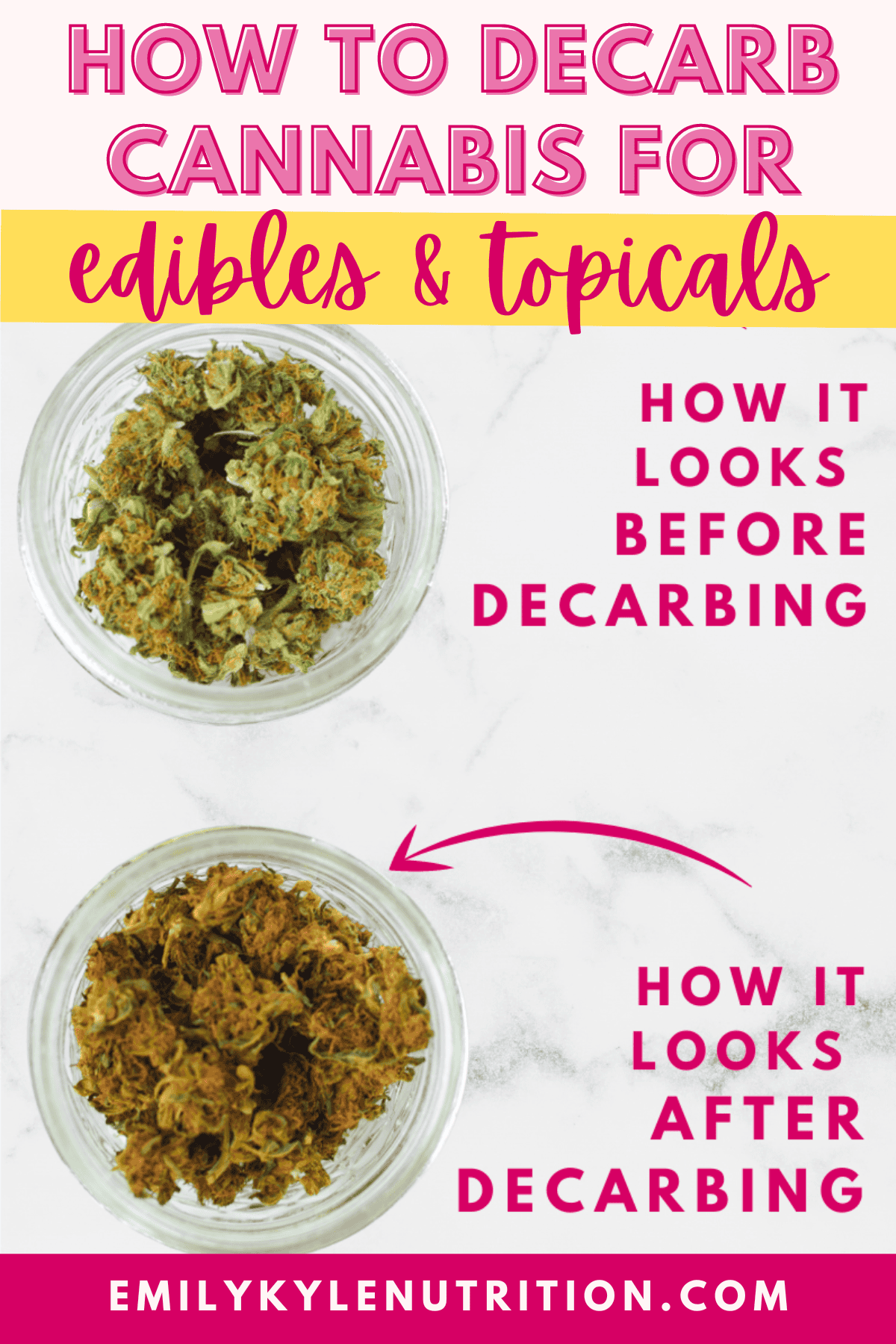
Table of Contents
- Features
- Why You Will Love This Guide
- What You’ll Need
- Step-by-Step Instructions
- Storage Instructions
- Why You Need to Decarb
- How to Decarb at Home
- Lab Tests
- What If I Don’t Decarb?
- It’s Not Going to Be Perfect
- Estimating The Potency
- How to Use Decarbed Cannabis
- How to Decarb Weed For Edibles Recipe
- Frequently Asked Questions
- More Articles You Will Love
Features
- The reason you need to decarb before making edibles
- Lab tests that show 240°F for 40 minutes is perfect for THC
- Tips and tricks to ensure your home decarb experience is smooth
Why You Will Love This Guide
A member of my Well With Cannabis Community recently asked me, “What exactly is decarboxylation, and why do we need to do it, anyway?”
Decarboxylation is the first step you need to take before infusing cannabis into oil, butter, tinctures, edibles, topicals, and more.
If you were to eat raw or dried cannabis, you would not likely feel any intoxicating effects of THC.
This is because cannabis does not contain high amounts of cannabinoids like THC; instead, it contains cannabinoid acids like THCA.
Cannabinoid acids have their own health benefits but are not intoxicating, meaning they won’t get you high.
To get the activated, psychoactive compounds we want, like THC, decarboxylation must occur.
Decarboxylation can easily be done in your kitchen at home by baking the dried cannabis in the oven at a low temperature for a certain period of time.
This guide will show you how you can decarb at home in your oven and explore the science behind the process; plus, I’ll share my expert tips and tricks so you will feel confident trying the process on your own.
Watch the Video
Prefer to watch or listen to this post instead? Click to watch the video.
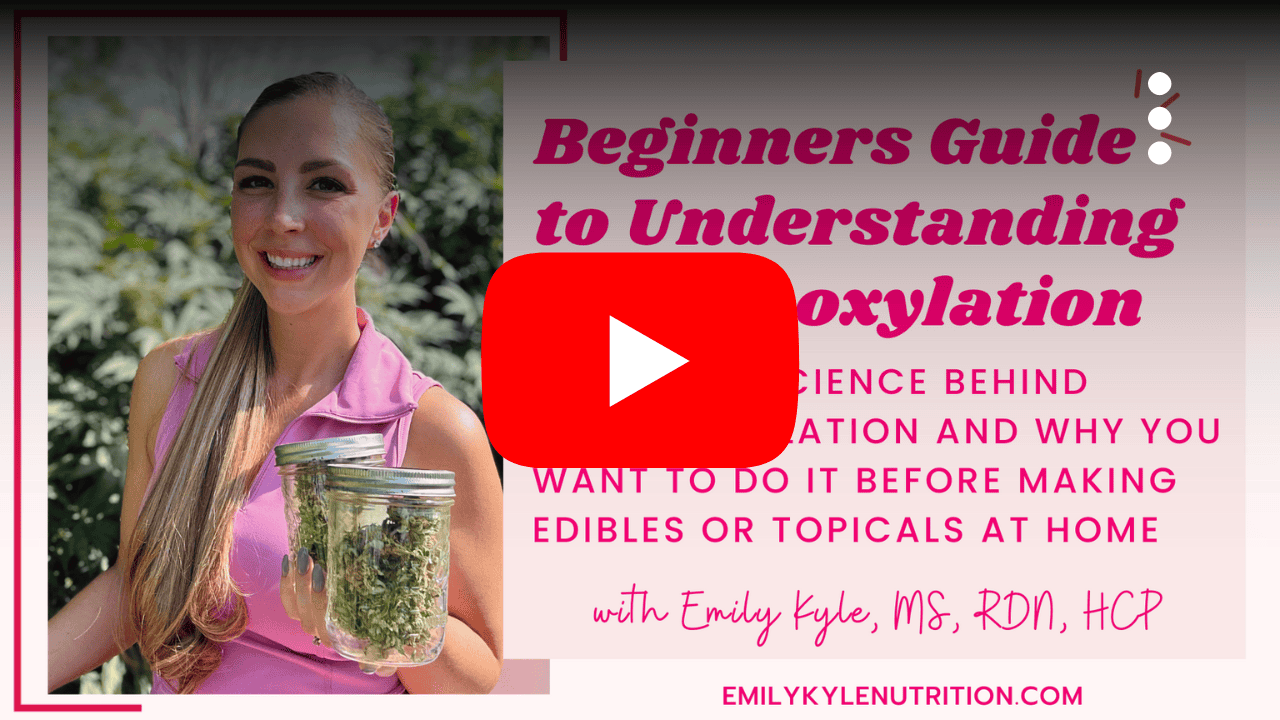
What You’ll Need
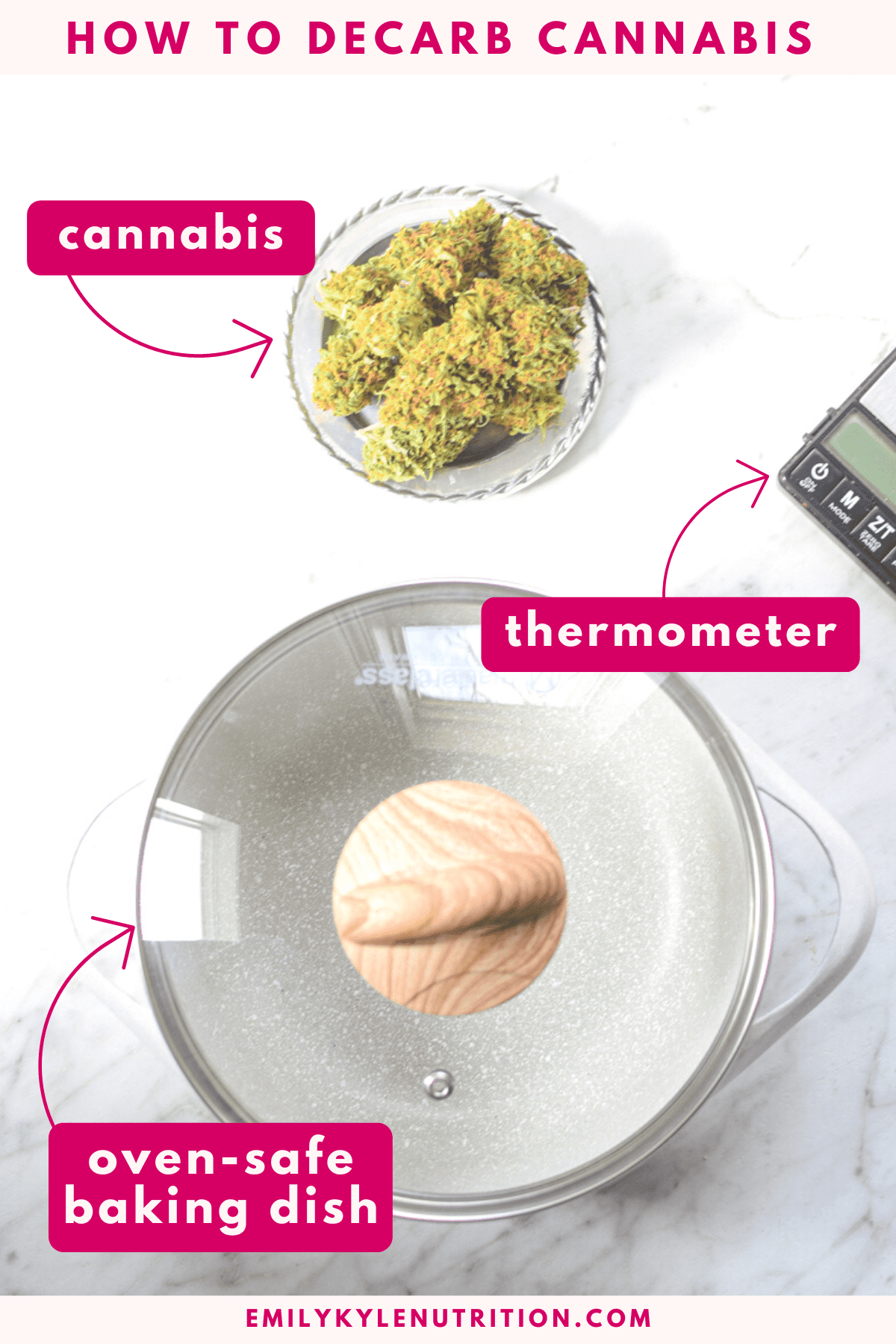
- Oven-safe baking dish: Using an oven-safe baking dish is the best practice. From a glass pie pan covered with foil to an old Pyrex baking dish with a lid, you want to ensure you are using something specifically designed to be used in an oven. It is not recommended to place mason jars in the oven; see FAQ below for more details.
- Digital scale: Weighing your material is optional, but using a scale is helpful if you use my edible dosage calculator to guestimate the potency of your final product.
- Digital thermometer: Optional, but a thermometer can help you reach your ideal temperature for your specific oven.
- Cannabis: This tutorial will work for any type of cannabis, including flowers, buds, trim, leaf, or shake. Check my other guides for how to decarb kief and decarb concentrates. Remember, it does not matter how much you decarb at once. From a gram to an ounce, the process remains the same.
Note: The recipe card below has a complete list of ingredients with amounts and printable instructions.
Step-by-Step Instructions
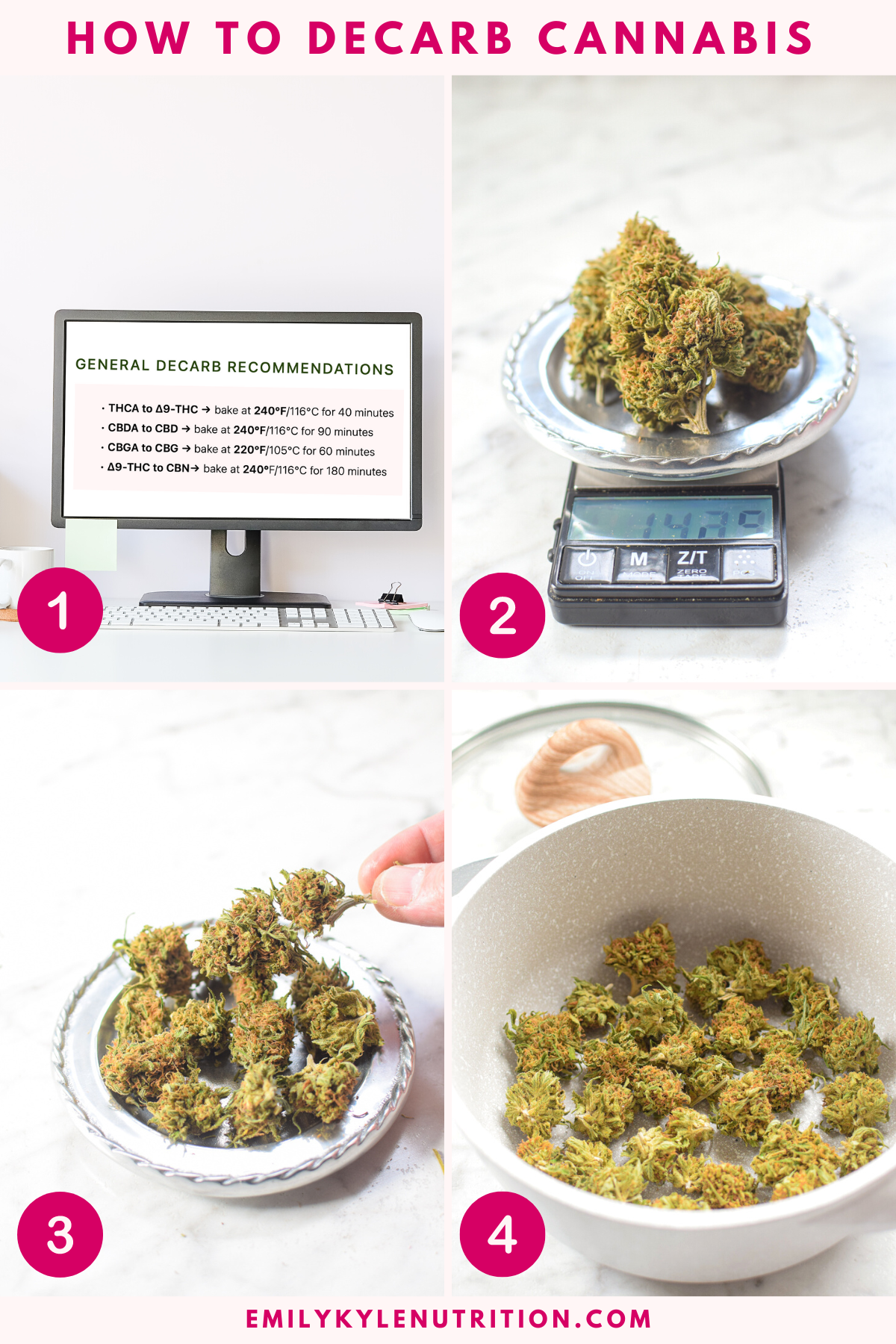
Decarb Times
- THCA → Δ9-THC – bake at 240°F/116°C for 40 minutes
- CBDA → CBD – bake at 240°F/116°C for 90 minutes
- CBGA → CBG – bake at 220°F/105°C for 60 minutes
- Δ9-THC → CBN – bake at 240°F/116°C for 180 minutes
- Step 1 – Use the General Decarb Recommendations above to determine what temperature to preheat the oven. Preheating the oven to 240° degrees Fahrenheit for THC-dominant flowers is commonly recommended.
- Step 2 – Using a digital scale, weigh the cannabis to your desired weight. This step is optional but helpful.
- Step 3 – Gently break up the cannabis buds into small pieces, and remove any seeds and stems as necessary. Do not grind.
- Step 4 -Add the flower to an oven-safe baking dish and put the lid on. You can cover the dish with tin foil if you don’t have a lid.
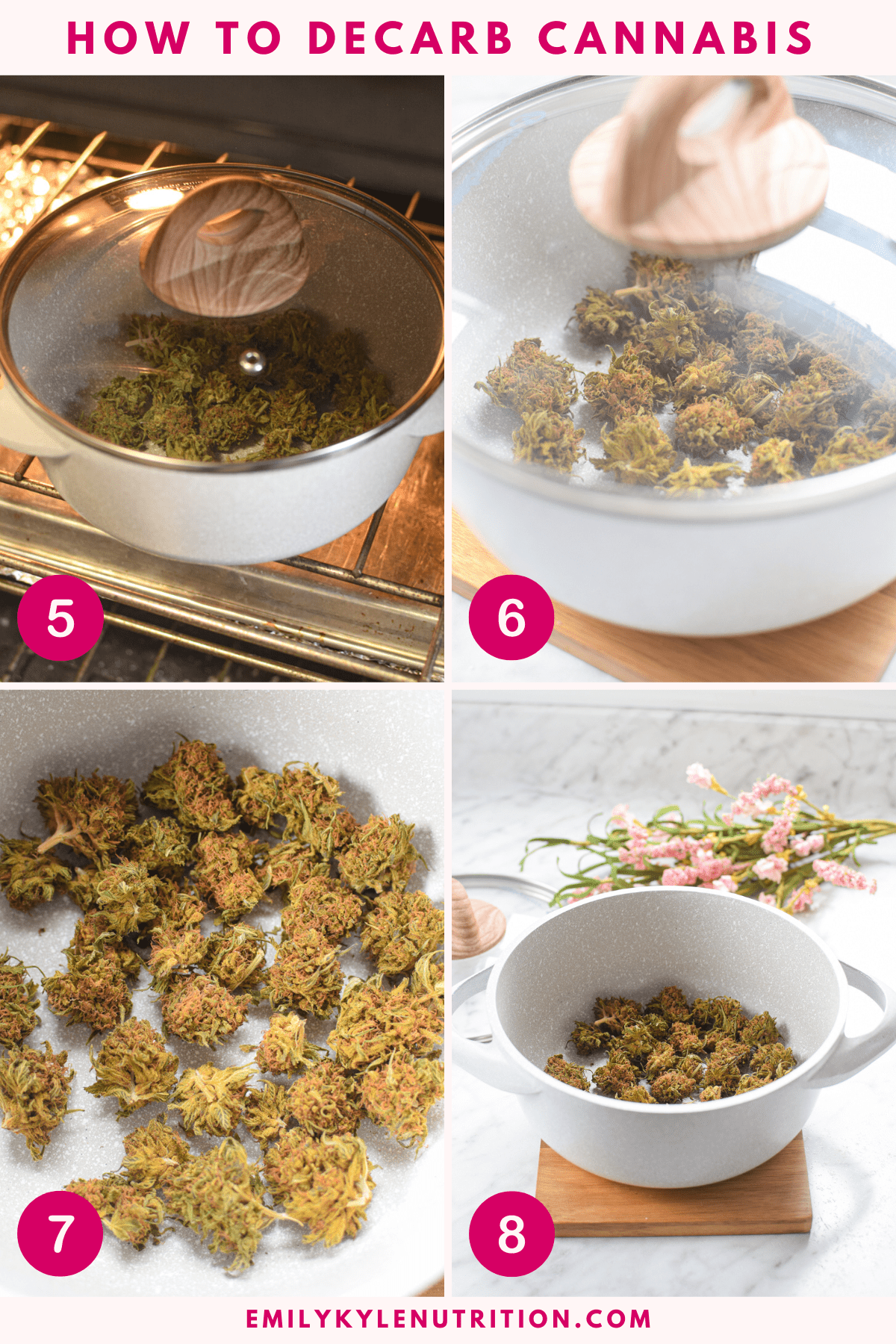
- Step 5 – Place the dish in the oven and bake for the time according to the chart, typically 40 minutes for THC-dominant flower.
- Step 6 – Carefully remove the dish to cool completely with the lid on.
- Step 7 – Your decarbed flower is now ready to use.
- Step 8 – See the storage instructions below to store your decarbed flower for future use.
Note: complete step-by-step printable instructions are located in the recipe card below.
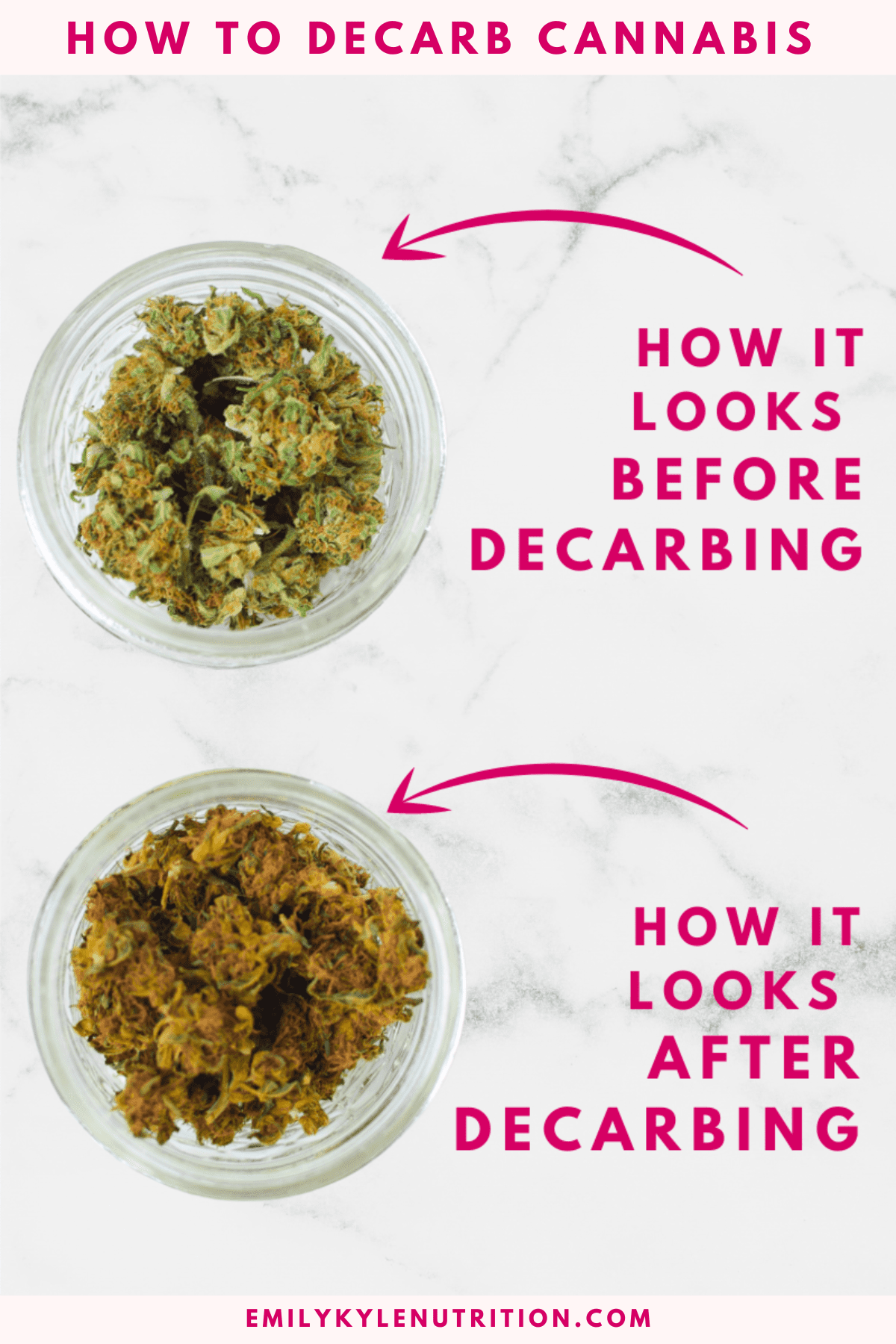
Storage Instructions
It is recommended to store the decarbed cannabis in an airtight container, like a mason jar, in a cool, dark place.
If you have a vacuum sealer, you can use it to seal your product in an airtight bag.
Don’t forget to add a Boveda pack or another moisture and humidity control option.
The freezer works well to help preserve the potency of THC, CBD, and other cannabinoids.
Why You Need to Decarb
If you’re new to cannabis or new to edibles, you may be frantically going down a rabbit hole searching all things decarbing.
What is this? Why do I need to do it? And why didn’t I know this sooner?
You probably did and just didn’t know it!
If you’ve ever smoked cannabis, the heat from the lighter touching the material decarbs for you, and then you inhale. The same is true when you push the button on a vape pen.
So eating dried or raw cannabis flower that has never been decarbed will provide little to no intoxicating effect or high.
This can be good or bad, depending on your desired experience!
By definition, decarboxylation is a chemical reaction that removes a carboxyl group and releases carbon dioxide.
Raw cannabis contains tetrahydrocannabinolic acid, or THCA for short.
This non-intoxicating substance can be converted into the intoxicating substance tetrahydrocannabinol, as you know it Δ9-THC, through the decarboxylation process1.
This process can also convert cannabidiolic acid, or CBDA, into cannabidiol or CBD, though both forms remain non-intoxicating.
While THCA and CBDA have their own potential health benefits, most people prefer to use the process of decarboxylation to enjoy active THC and CBD.
While there is a general understanding of the science behind the decarboxylation process, truthfully, it is all just one big experiment in a home kitchen.
Ultimately, they all get you to the same place – decarbed cannabis flower with the psychoactive effects you desire.
How to Decarb at Home
Decarboxylation occurs when cannabis is exposed to heat, light, cofactors, or solvents.
The easiest way to decarb in your at-home kitchen environment is with heat, like an oven or an Instant Pot.
The goal is to heat the material at a low temperature to allow decarboxylation to occur without destroying the other beneficial compounds like terpenes or flavonoids.
This becomes difficult because each cannabinoid decarboxylates on its own specific temperature/time scale.
THCA begins to decarboxylate at approximately 220°F after around 30-45 minutes of exposure, with full decarboxylation typically taking longer to occur2.
If you are working with CBD flowers, know that CBDA requires more time to achieve decarboxylation than traditional THC-dominant flowers.
Each individual terpene may have its own therapeutic health benefits but also carries its own sensitivity to heat.
Also, know that the type and strain of cannabis you are using will impact your final results.
This is why you will want to consider the best temperature and cooking time for each strain before starting.
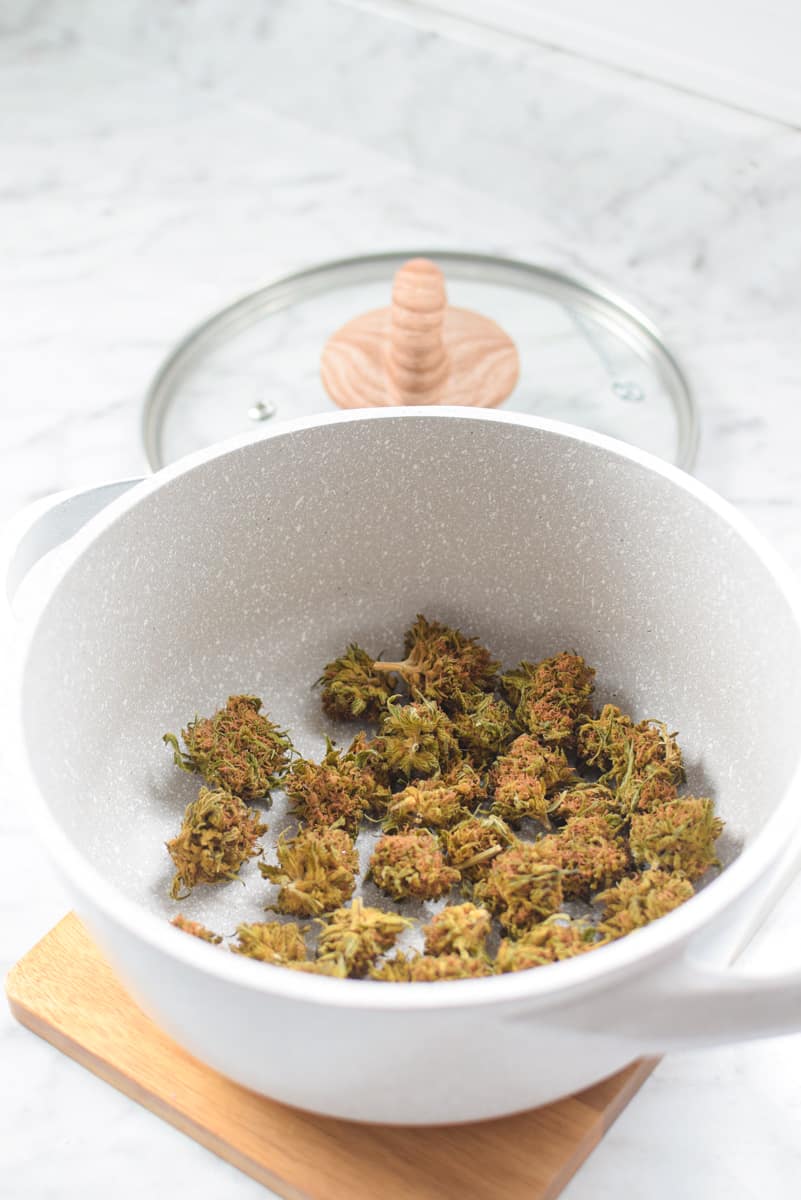
Experiment With Different Temperatures
Feel free to experiment with other recommendations to see what you like best; there are many ways to reach the final destination.
If you want to decarb weed at higher temperatures, know you will need less time to achieve decarb.
Just be wary of extreme temperatures or methods that may introduce high temperatures, like broiling, microwaves, or grills.
While heat is needed to decarboxylate, extreme temperatures can destroy many important compounds that contribute to positive health outcomes3.
Lab Tests
I didn’t have access to lab testing when I wrote this post nearly four years ago.
I simply went with “what everyone recommended,” and that was to bake at 240°F for 40 minutes.
Thankfully, times have changed, and I can run lab tests and gather real-world data.
While this test is just a single test subject to all of the different variables of an at-home kitchen, these results were exciting.
The first lab test shows the cannabinoid makeup of the flower before decarboxylation; this is our control and how we know where we’re starting.
The second test shows how the cannabinoid makeup changed after the decarb process.
You can see that the first test had 1.34% THC and 18.75% THCA, and the second test had 17.12% THC and 0.40% THCA.
While not 100%, these tests show nearly perfect conversion.
This helps me sleep at night, knowing that the recommendation to decarb at 240°F for 40 minutes is effective and accurate.
Before Decarb
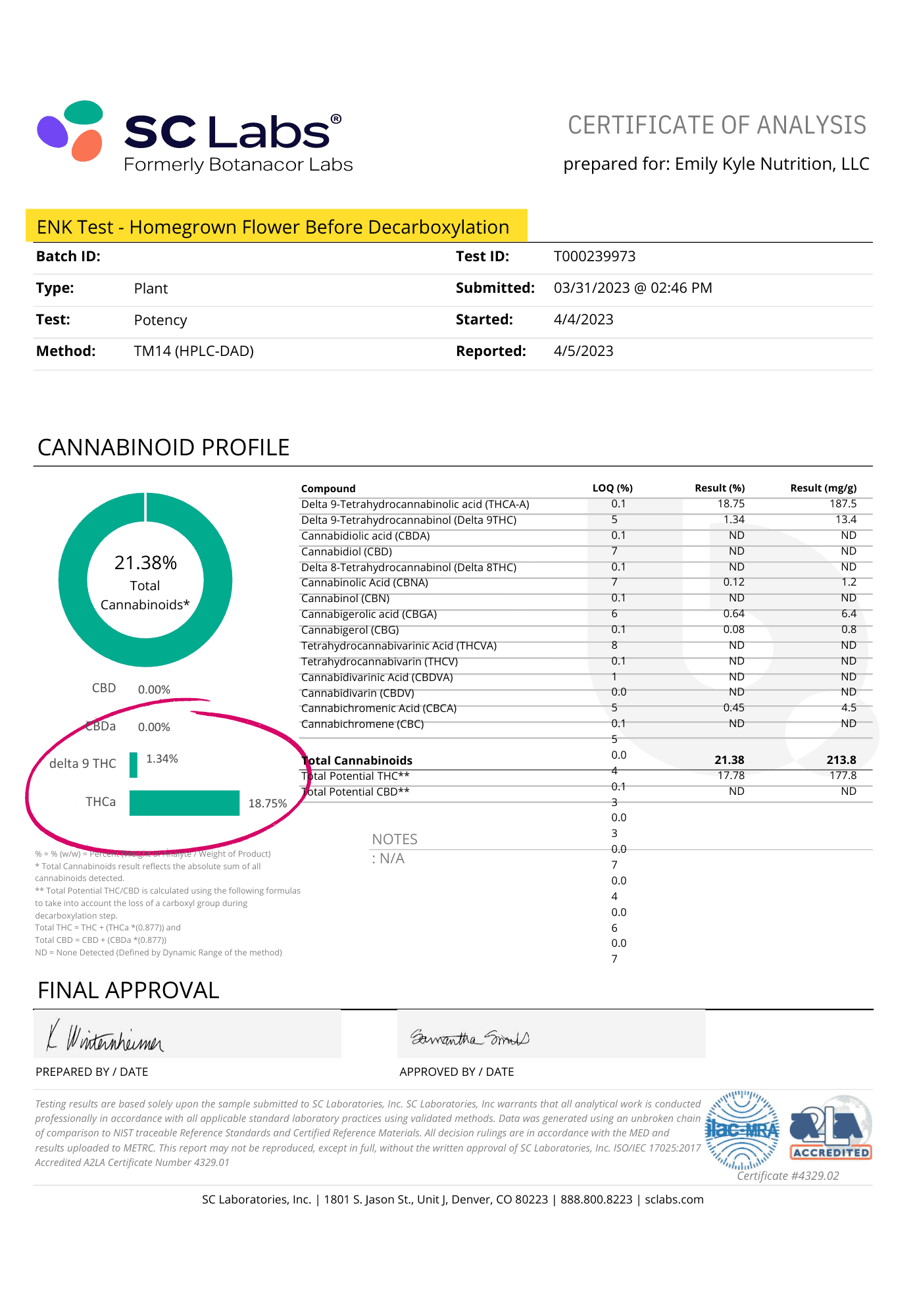
After Decarb
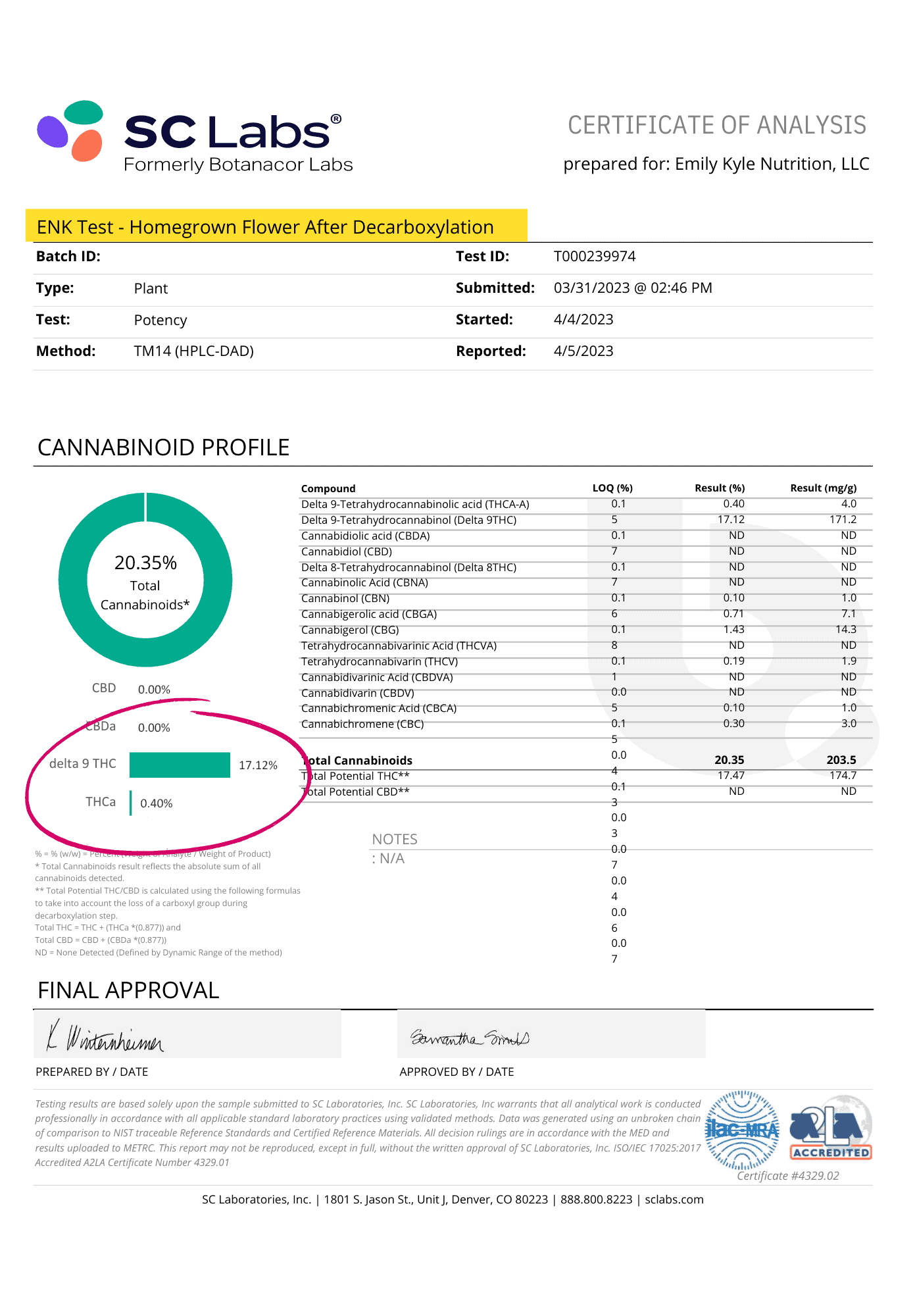
What If I Don’t Decarb?
If I had a dollar for every time I heard: “Back in the day, we didn’t do that decarb thing. We just left it in the crockpot for 24 hours, and it was plenty strong!”
And that is totally true, and I bet the butter was super strong – and green and grassy.
Decarboxylation occurs on a time-temperature scale, meaning that decarb can be achieved at different times and temperatures.
They didn’t think they were decarbing back in the day, but they were!
Leaving the material in a 160°F crockpot for 24 hours caused decarb to occur, just at a lower temperature and a longer time.
The reason we recommend the new, quicker oven method of decarbing before infusing is multifactored; it helps ensure maximum cannabinoid activation and terpene retention.
But ultimately, it makes your butter, oil, and other edibles taste better.
Long infusion times cause the plant material to release a lot of a green pigment called chlorophyll.
While chlorophyll is harmless, it is NOT tasteless. This is what gives homemade edibles their sometimes unpleasant taste.
By decarbing first, quickly and then opting for a quicker 4-hour infusion, the goal is that you end up with a more potent, better-tasting end product.
This is my favorite way to create all of my popular staple oils, including:
- Cannabutter
- Cannabis coconut oil
- Cannabis olive oil
- Cannabis MCT oil
- Full-extract cannabis oil (FECO)
Remember, without decarboxylation, you will not experience the full range of active ingredients like THC and CBD.
It’s Not Going to Be Perfect
If you ask ten members of my Well With Cannabis Community how they decarboxylate cannabis, you will likely get ten different answers.
While variations of each method are slight, they are usually accompanied by years of experience and personal preference.
It’s important to remember that this is not a perfect process in a controlled lab environment, nor does it need to be.
Each cannabis plant is unique and contains a full spectrum of compounds, including cannabinoids, terpenes, and more.
The ratio of compounds varies from plant to plant, and each one decarbs at a different temperature, making perfect, consistent results challenging.
On top of that, we all have different kitchen setups with different equipment available to work with.
However, this is not to discourage you.
While this sounds like one big science experiment going on in your kitchen, it really is as simple as putting cannabis in the oven and baking it.
Ultimately, we all arrive at the same goal, activated THC and CBD that can be used in homemade edibles, topicals, and more.
If you strongly desire to be as precise as possible, here are a few considerations to remember.
Temperature Control
Temperature fluctuations can vary greatly from oven to oven, making tight temperature control difficult.
Many variables can impact the final temperature of the oven, and even two same-brand ovens may vary in temperature by 5-10 degrees or more.
For this reason, I recommend using an oven-safe thermometer so that you can track the temperature in the oven that you currently have.
I also recommend limiting the number of times the oven door is opened during the cooking process, as this alters the oven temperature significantly.
Opening the door will cause the temperature to drop and alter your time and temperature recordings’ reliability.
Different Equipment
You are not limited to using an oven for this process; other pieces of equipment, like an Instant Pot, air fryer, or decarb machine, can be used.
Basically, anything that can hold a consistent temperature of around 240°F can be used – I’ve even seen a guy use a smoker to decarb cannabis and another using a toaster oven outside in the garage.
Different methods will have different temperature controls, so I recommend you use a thermometer as needed throughout the process.
Small variables in the different types of cooking equipment may impact your final product, but it is a great idea to experiment with different options to find what works best for you.
Important to note if you want to contain the smell as much as possible, using an Instant Pot or infusion machine can help.
Estimating The Potency
Perhaps the only downside of making homemade edibles is that it is nearly impossible to determine the final potency of THC or CBD per serving.
This is a disadvantage because it is hard to accurately dose correctly, and then it becomes difficult to assess and track how each option makes you feel.
Unfortunately, without lab testing, it is nearly impossible to accurately assess the final product’s total cannabinoid concentration, like total mg of THC or mg of CBD.
This uncertainty increases the risk of underdosing or overdosing, ultimately preventing you from experiencing the desired health benefits.
However, you can use my edibles dosage calculator to get a guesstimate of your final potency.
This calculator is the first of its kind to offer the ability to account for the natural potency loss associated with the decarboxylation process, which is calculated at 0.87%.
This means that if you started with 100mg of THCA, in a perfect scenario, you would get 87mg of THC in the end.
Thankfully, my calculator does all the math for you, and all you need to do is check the box.
How to Use Decarbed Cannabis
Once the decarbing process is over, the world is your oyster!
You can use it to make butter, oils, tinctures, topicals, and a wide range of cannabis products – you dream it, you can make it.
Or, you don’t have to do anything at all; you can grind the weed into a fine powder and enjoy the decarbed weed as-is, similar to how other dried herbs are used.
This powder can be sprinkled onto food, added to your favorite recipe like my cannabis ranch dressing, or put into capsules for easy consumption.
Members of my Well With Cannabis Community make their own tea, honey, or seasoning blends with their decarboxylated cannabis flower.
Others will move forward to use the decarbed cannabis flower to make a cannabis-infused oil or cannabis-infused butter with a simple infusion process.
The infusion process is easy and can be done in different ways: with a slow cooker water bath, a precision cooker like an Instant Pot, or the sous vide method with an immersion circulator.
Once your oil infusion is made, you can make cannabis edibles or these amazing recipes.
What to Do with Decarbed Cannabis
Articles & How-To Guides
How To Use Just Decarbed Cannabis in Edibles
Cannabis Infusions & Extractions
How to Make Cannabis Capsules
Cannabis Sides & Snack Recipes
Cannabis Firecrackers » Easiest Edible Ever
Gluten-Free
Easy Savory CBD Seasoning & Rub
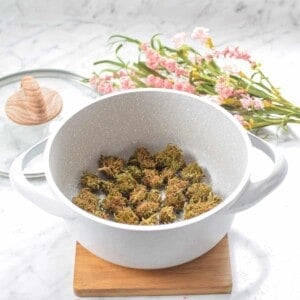
How to Decarb Weed For Edibles
Watch The Video
Equipment
What You Need
- 1 ounce cannabis *any amount is fine
Instructions
- Remember, each cannabinoid decarbs at a different temperature. Pick the dominant cannabinoid you know is present in your material and select the time and temperature associated with it using the recommendations below.
- Preheat the oven to the temperature you need, commonly 240° F for THC-dominant cannabis.
- Using a digital scale, weigh the cannabis to your desired weight. For example: in grams or ¼- 1 ounce. This step is optional but helpful if you plan to use my edible dosage calculator.
- Gently break up any large cannabis buds; popcorn-sized pieces are good. Remove any seeds and stems as necessary. I do not recommend grinding before decarbing.
- Add the material to an oven-safe baking dish and secure the lid. If you don't have a lid, tightly cover the dish with tin foil.
- Place the dish in the oven and bake for your desired time according to the recommendations below, most commonly 40 minutes for THC-dominant cannabis.
- Resist the urge to open the oven, lift the lid, or otherwise check on the material. Let it bake uninterrupted for the desired amount of time. After the cooking time, remove the dish from the oven and let it cool completely with the lid on.
- Your decarbed flower is now ready for use. If you do not want to use it immediately, store it in an airtight container in a cool, dark place. See additional storage instructions below.
Notes
-
- THCA to D9-THC → bake at 240°F for 40 minutes
- CBDA to CBD → bake at 240°F for 90 minutes
- CBGA to CBG → bake at 220°F for 60 minutes
- THC to CBN→ bake at 240°F for 180 minutes
Frequently Asked Questions
No worries, I am here to help you! If you haven’t already, check out my guide to help you on your cannabis journey. And be sure to grab your free copy of my printable terms & abbreviations chart.
While it is very common and popular to decarb cannabis in a mason jar, Ball canning jars are not recommended to be used in the oven. A lid sealed too tight could cause a jar to crack, break, or explode. For this reason, we recommend baking the cannabis in an oven-safe baking dish with a lid.
If you don’t have a dish safe in the oven, you can use a baking sheet or tray covered with aluminum foil or parchment paper. Just know that this will not hold in the smell as well as a covered option.
This is a matter of personal preference. Grinding will remove trichomes, leaving them in the grinder and not on your material. Grinding will also expose more surface area, allowing more chlorophyll to be absorbed into the final product. This is why I recommend skipping the grinding process and breaking up large buds by hand into smaller, popcorn-sized pieces instead.
Yes, decarbed cannabis can be stored for quite a long time. It is recommended to store the decarbed cannabis in an airtight container, like a mason jar, in a cool, dark space. The freezer works well to help preserve the potency of THC and CBD.
Yes – the decarboxylation process can cause your house to smell like weed. This is because, when we bake cannabis, we activate and release certain terpenes, which give cannabis its distinct smell. While some enjoy the wonderful aroma, others are concerned about the smell affecting a loved one, a neighbor, or someone else in the home. That is why we recommend baking the cannabis flowers in a sealed container, like an oven-safe baking dish with a lid. You can contain the smell even further by decarbing in an Instant Pot. The sealed lid will hold in many terpenes, which is great for your final product and helps significantly reduce odor.
Yes, you can absolutely just eat the cannabis as-is after the decarb process. Some prefer grinding it into a fine powder, like other herbs like oregano. If you will consume this year, it is a good idea to be extra cautious. Depending on your material, this method can be very potent, with even just a few grams able to pack a potent THC punch.
Each human body has an endocannabinoid system with cannabinoid receptors that interact with the cannabis we consume.
More Articles You Will Love
Articles & How-To Guides
How To Decarb In An Instant Pot » No Smell Method
Articles & How-To Guides
How to Decarb Kief & Make Edibles
Articles & How-To Guides
How To Use Just Decarbed Cannabis in Edibles
Articles & How-To Guides

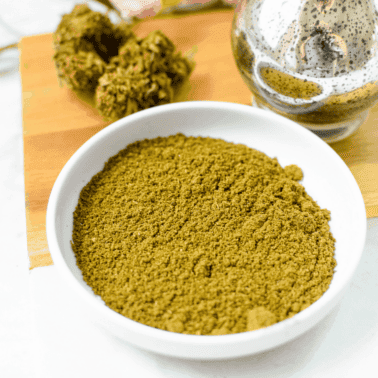
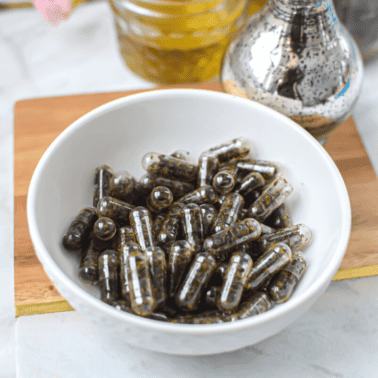
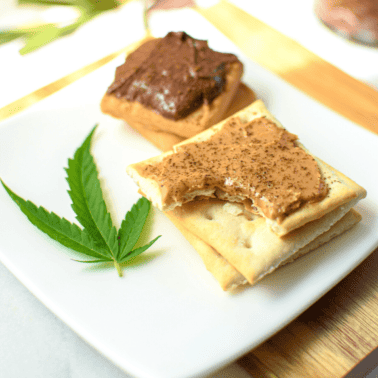
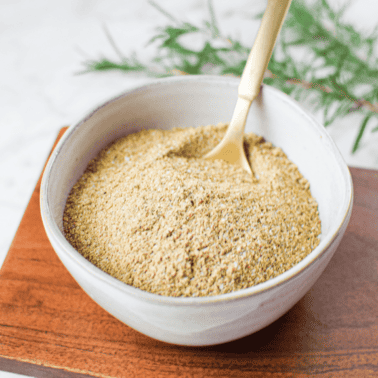
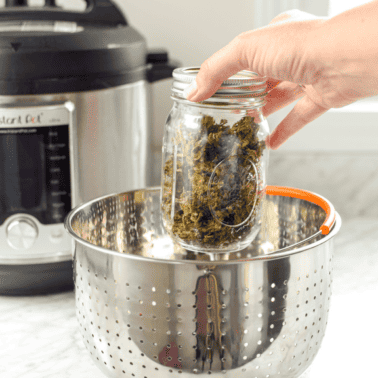
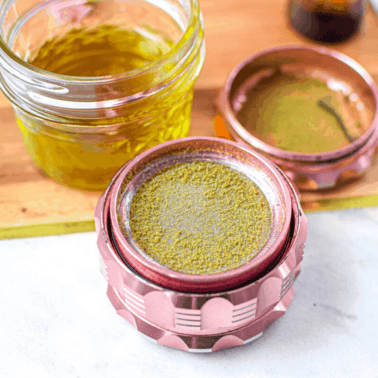
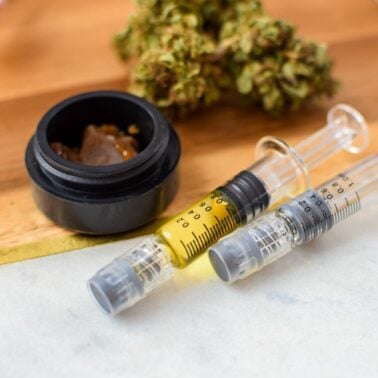
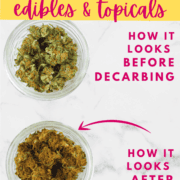








In getting a lot of cbg-a keif what can I make with that can I make a wax or concentrate out of it if so pls lead me in the right steps I’d greatly appreciate it or anything really easy to make. Thanks Chason
Hello Chason, yes, you can use it to make full-extract cannabis oil, which is a concentrate easy enough to make at home. Here’s the recipe, I hope this helps!
Hello! I decarbed in the oven, but on a cookie sheet with no lid or foil to cover, before reading your recommendations. What does the lid do for the process?
Thank you!
Hello Kim! Using a lid or foil helps to retain the terpenes and prevent the loss of volatile compounds during the decarbing process. It can also help in maintaining a more consistent temperature. However, if you didn’t use one this time, you should still have effective results. Feel free to try it next time to see if you notice any difference. Thanks for reaching out!